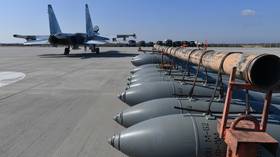Russia’s new gliding bomb to go into serial production – media

Russia will reportedly start mass-producing a new gliding aerial bomb this year, following a protracted development phase. The weapon has proven highly successful in the Ukraine conflict, during which the Russian military retrofitted older bombs with upgrade kits.
The new weapon, the PKB-500U Drel (‘drill’ in Russian), has completed all trials, defense giant Rostec said on Wednesday, as quoted by TASS. Some of the tests were classified, having been conducted in the combat environment of the Ukraine conflict, the statement said.
“The first series part of the Drel aerial bomb is planned for 2024,” the report added.
Gliding bombs are a relatively cheap type of weapon which use fins to extend their range, but unlike missiles, have no expensive engines. They can still be dropped by high-flying warplanes without entering the range of short-range enemy air defense systems. Modern variants are also normally equipped with a guidance system to ensure accuracy.
Amid the conflict with Ukraine, Russia launched mass production of upgrade kits that can convert older models stockpiled in its arsenals into gliding bombs. Western media outlets have said these weapons are a major threat to Ukrainian frontline troops.
The Drel was conceptualized in the 1990s, but active development started much later – the necessary space infrastructure was not in place three decades ago. It uses the Glonass satellite navigation system for targeting. The main research and development phase was reportedly completed in 2016, but field testing was delayed.
Bazalt, the defense engineering lab that developed the Drel, touts it as an advanced cluster weapon. Each 540-kg bomb carries 15 individually-targeted parachute-equipped submunitions, which can be tailored for specific targets, such as armored vehicles or radar stations.
They are also said to have special programming to prevent damage to non-military targets and ensure that submunitions are not left as duds – unexploded ordnance that makes older cluster weapons highly dangerous for civilians.
The bomb is said to be deployable from altitudes between 100 meters and 14 kilometers by aircraft flying at speeds of 700 to 1,100kph. Drel’s maximum range is reportedly 30km.
Tecmash, a Rostec subsidiary that owns Bazalt, has said that the technology used in the Drel can be repurposed for civilian applications, including airdropping emergency supplies to remote areas with high precision.














